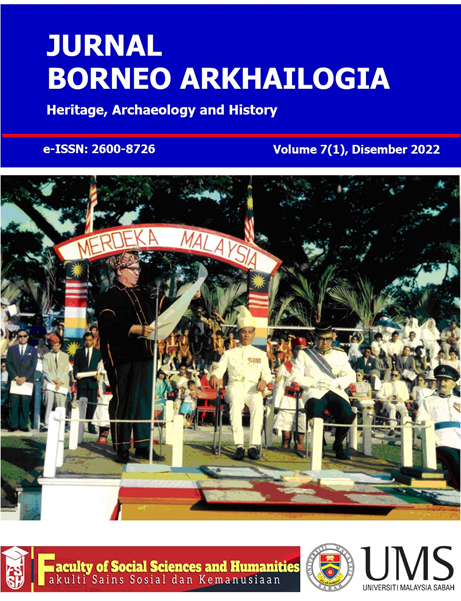THE ADAPTATION OF NATURE IN IBAN CULTURAL ARTEFACT
DOI:
https://doi.org/10.51200/jba.v7i1.4133Keywords:
Artifacts, Borneo, culture, human, Iban, SarawakAbstract
Iban or also known as Sea Dayak has inhabited the island of Borneo for hundreds of years. From the previous timeline, the Iban community has adapted to their surrounding nature in developing their culture which is consisted of customs based on the foundation of ancestral beliefs. As a result, the development of Iban culture became more creative and innovative in producing cultural artifacts referring on surrounding nature. Incidentally, the cultural developed by the early Iban have become a legacy and identity for the modern Iban society today. Therefore, this paper is an ethnographic studies emphasis on human artifacts. Therefore, the scope of this studies discussed the researcher's proposed theory of the role of nature that has contribute to shaped human cultural artifacts, particularly the Iban cultural artifacts. This study applied qualitative methods and the research findings have concluded that nature have a significant function as a driving force to influenced early human culture and experience changes based on relevance and human preferences.
References
Book and Journal
Cottrell, L. (2006). The lost pharaohs. New York: Routledge.
Crabtree, R. D. (2011). Progress and promise for international service-learning. Michigan Journal of Community Service Learning, 17(2), 78-83.
Dant, T. (2007). Material culture. The Blackwell Encyclopedia of Sociology, -.
Ferraris, M., & Torrengo, G. (2014). Documentality: A theory of social reality. Rivista di Estetica, (57), 11-27.
Fleming, E. M. (1974). Artefact study: A proposed model. Winterthur Portfolio, 9, 153-173.
Habermas, J. (2001). The liberating power of symbol: Philosophical essays (P. Dews, Trans.). Cambridge, UK: Polity Press.
Hole, F., Heizer, R. F., & Yaacob, S. (1990). Arkeologi prasejarah: Satu pengenalan ringkas. Kuala Lumpur: Dewan Bahasa dan Pustaka.
Jais, A.W. & Abdul Rashid, A.A. (2007). Artifak peradaban Melayu dalam koleksi Muzium Seni Asia Universiti Malaya: Usaha mewujudkan inventori budaya / Abd. Wahid Jais. In Persidangan Antarabangsa Peradaban Melayu III.
Jusoh, A. (2010). Loceng gangsa purba di Malaysia: Sumbangannya dalam penyelidikan peradaban masyarakat peribumi purba. Jurnal Melayu, 5.
Margolis, E., & Laurence, S. (2007). The ontology of concepts-abstract objects or mental representations? Noûs, 41(4), 561-593.
Mead, G. H. (1929). The nature of the past. United States: Holt.
Nankivell, B. J., Borrows, R. J., Fung, C. L. S., O'Connell, P. J., Chapman, J. R., & Allen, R. D. (2004). Calcineurin inhibitor nephrotoxicity: longitudinal assessment by protocol histology. Transplantation, 78(4), 557-565.
Navis, A. A. (1984). Alam terkembang jadi guru: Adat dan kebudayaan Minangkabau. Grafiti Pers.
Olick, J. K. (1999). Collective memory: The two cultures. Sociological theory, 17(3), 333-348.
Payne, Robert. (1986). The White Rajah of Sarawak. Singapore: Oxford University Press.
Petraglia, M. D., Haslam, M., Fuller, D. Q., Boivin, N., & Clarkson, C. (2010). Out of Africa: New hypotheses and evidence for the dispersal of Homo sapiens along the Indian Ocean rim. Annals of Human Biology, 37(3), 288-311.
Posner, R. (2003). Basic tasks of cultural semiotics. Semiotics, 307-353.
Pringle, R. (1970). Rajahs and rebels: The Ibans of Sarawak under Brooke rule, 1841-1941. Universiti Malaysia Sarawak.
Rahman, N. H. S. N. A. (1985). Artifak Kebudayaan Melayu: Sumbangan arkeologi dan arkeologis. Perspektif: Jurnal Sains Sosial dan Kemanusiaan, 2(1), 140-150.
Ramli, Z. (2015). Zaman prasejarah di Malaysia dalam konteks tinggalan masyarakat persisir pantai. Jurnal Arkeologi Malaysia, 28.
Sandin, B. (1967). The Sea Dayaks of Borneo before White Rajah rule. London, Melbourne.
Simonson, T. S., Xing, J., Barrett, R., Jerah, E., Loa, P., Zhang, Y., ... & Mowry, B. (2011). Ancestry of the Iban is predominantly Southeast Asian: genetic evidence from autosomal, mitochondrial, and Y chromosomes. PloS one, 6(1), e16338.
Sutlive Jr, V. H. (1992). Tun Jugah of Sarawak: Colonialism and Iban response. Kuala Lumpur: Fajar Bakti Sdn. Bhd.
Tuan Yu-Fu, (1980). The significane of the artifacts, geographial review. American Geography Society, 4 (70).
Tugang, N. (2011). Tembikar dalam budaya Iban di Sarawak. Universiti Malaysia Sarawak.
Downloads
Published
How to Cite
Issue
Section
License
Penyerahan manuskrip mensyaratkan bahawa manuskrip tidak pernah diterbitkan di tempat lain ataupun sedang dipertimbangkan untuk penerbitan oleh penerbit lain. Jika dan apabila manuskrip telah diterima untuk penerbitan, maka penulis bersetuju untuk memindahkan secara automatik hak cipta kepada penerbit ©Universiti Malaysia Sabah. Hak cipta terpelihara. Tiada bahagian daripada terbitan ini boleh diterbitkan semula dalam bentuk apa pun atau dengan cara apa pun tanpa kebenaran bertulis terbelih dahulu daripada penerbit.
Permintaan kepada Penerbit untuk kebenaran hendaklah dialamatkan kepada:
Penerbit UMS,Tingkat Bawah Perpustakaan,Jalan UMS, Universiti Malaysia Sabah,88400 Kota Kinabalu, Sabah, Malaysia.Tel: (+6088) 320000 Ext. 1015Fax: (+6088) 320446 E-mail: penerbit@ums.edu.my
++++++++++++++++++++++++++++++++++++++++++++++++++++++++++++++++++++++++++++++++++++++++++++++++++++++++++++
Submission of article implies that the article has not been previously published elsewhere nor is under consideration for publication by another publisher. If and when the article is accepted for publication, the authors agree to automatic transfer of the copyright to the publisher ©Universiti Malaysia Sabah. All rights reserved. No part of this publication may be reproduced in any form or by any means, without the prior written permission of the publisher.
Requests to the Publisher for permission should be addressed to:
Penerbit UMS,Ground Floor Library,Jalan UMS, Universiti Malaysia Sabah,88400 Kota Kinabalu, Sabah, Malaysia.Tel: (+6088) 320000 Ext. 1015Fax: (+6088) 320446 E-mail: penerbit@ums.edu.my






